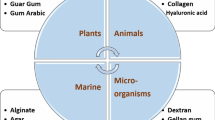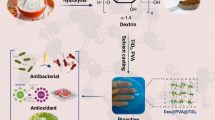Abstract
The potential application of polysaccharide-based films containing smart nanohydrogels for the controlled release of food preservatives is demonstrated here. Smart active packaging is the most promising alternative to traditional packaging as it provides a controlled antimicrobial effect, which allows reducing the amount of preservatives in the food bulk, releasing them only on demand. This work evaluates the usefulness of smart thermosensitive poly(N-isopropylacrylamide) (PNIPA) nanohydrogels with or without acrylic acid (AA) incorporated into polysaccharide-based films (GA) to transport natamycin and release it as a response to environmental triggers. Release kinetics in liquid medium from GA films containing PNIPA/AA nanohydrogels (GA-PNIPA(5) and GA-PNIPA-20AA(5)) presented a characteristic feature regarding the films without nanohydrogels that was the appearance of a lag time in natamycin release, able to reach values of around 35 h. Another important feature of natamycin release kinetics was the fact that the release from GA-PNIPA/AA films only occurred when temperature was increased, so that the natamycin release was restricted to when there is a risk of growth of microorganisms that cause food spoilage or the development of pathogenic microorganisms. Additionally, it could be observed that the relative fraction of natamycin released from GA-PNIPA/AA films was significantly (p < 0.05) higher than that released from GA films loaded with the same amount of free natamycin. It can be hypothesised that the encapsulation of natamycin into nanohydrogels helped it to be released from GA films, creating reservoirs of natamycin into the films and, therefore, facilitating its diffusion through the film matrix when the nanohydrogel collapses. In a solid medium, the low water availability limited natamycin release from GA-PNIPA/AA films restricting the on/off release mechanism of PNIPA/AA nanohydrogels and favouring the hydrophobic interactions between natamycin and polymer chains at high temperatures. Despite the low natamycin release in solid media, antimicrobial efficiency of GA-PNIPA(5) films containing natamycin in acidified agar plates was higher than that obtained with GA films without natamycin and GA films with free natamycin, probably due to the protecting effect against degradation when natamycin was included in the nanohydrogels, allowing its release only when the temperature increased.



Similar content being viewed by others
Abbreviations
- AA:
-
Acrylic acid
- AP:
-
Aqueous phase
- AtlasTM G-1086:
-
PEG-40 sorbitol hexaoleate
- DL:
-
Detection limit
- F t :
-
Fraction of natamycin released from films towards agar plates
- GA-NA:
-
GA films containing free natamycin
- GA-PNIPA-20AA(5):
-
Polysaccharide-based films containing PNIPA-20AA(5) nanohydrogel
- GA-PNIPA-20AA(5)+NA(8):
-
GA films containing PNIPA-20AA(5) nanohydrogels loaded with 7.92 μg of natamycin
- GA-PNIPA(5):
-
Polysaccharide-based films containing PNIPA(5) nanohydrogel
- GA-PNIPA(5)+NA(8):
-
GA films containing PNIPA(5) nanohydrogels loaded with 7.92 μg of natamycin
- GA-PNIPA/AA:
-
Polysaccharide-based films containing poly(N-isopropylacrylamide) nanohydrogel with or without copolymerised acrylic acid
- GA:
-
Polysaccharide-based films
- GA + NA(564):
-
GA films containing 564.24 μg of free natamycin
- GA + NA(8):
-
GA films containing 7.92 μg of free natamycin
- IsoparTM M:
-
Isoparaffinic synthetic hydrocarbon
- LCST:
-
Lower critical solution temperature
- MIC:
-
Minimum inhibitory concentrations
- n :
-
The diffusional exponent that depends on both the geometry of the delivery system and the physical mechanisms involved
- NIPA:
-
N-isopropylacrylamide
- NMBA:
-
N,N′-methylenebisacrylamide
- OP:
-
Oil phase
- P 1.01:
-
Penicillium commune
- PDA:
-
Potato dextrose agar
- PNIPA-20AA(5):
-
Poly(N-isopropylacrylamide) nanohydrogel copolymerised with 20 % (w/w) of acrylic acid using 5 % (w/w) of crosslinking
- PNIPA:
-
Poly(N-isopropylacrylamide)
- PNIPA(5):
-
Poly(N-isopropylacrylamide) nanohydrogel with 5 % (w/w) of crosslinking
- PNIPA/AA:
-
Poly(N-isopropylacrylamide) nanohydrogel with or without copolymerised acrylic acid
- RP-HPLC:
-
Reverse phase high-performance liquid chromatography
- Sc 1.02:
-
Saccharomyces cerevisiae
- SpanTM 83:
-
Sorbitan sesquiolate
- ST:
-
Surfactant
- v max :
-
Maximum release rate (h−1)
- γF max :
-
Maximum relative fraction of natamycin released from films
- γF t :
-
Relative fraction of natamycin released from films
- λ :
-
The lag time for the natamycin release, expressed in hours (h)
References
Ahuja, N., Katare, O. P., & Singh, B. (2007). Studies on dissolution enhancement and mathematical modeling of drug release of a poorly water-soluble drug using water-soluble carriers. European Journal of Pharmaceutics and Biopharmaceutics, 65(1), 26–38.
Bierhalz, A. C. K., Da Silva, M. A., & Kieckbusch, T. G. (2012). Natamycin release from alginate/pectin films for food packaging applications. Journal of Food Engineering, 110(1), 18–25.
Blanco, M. D., Guerrero, S., Teijón, C., Olmo, R., Pastrana, L., Katime, I., et al. (2008). Preparation and characterization of nanoparticulate poly(N-isopropylacryl-amide) hydrogel for the controlled release of anti-tumour drugs. Polymer International, 57(11), 1215–1225.
Bourbon, A. I., Pinheiro, A. C., Ribeiro, C., Miranda, C., Maia, J. M., Teixeira, J. A., et al. (2010). Characterization of galactomannans extracted from seeds of Gleditsia triacanthos and Sophora japonica through shear and extensional rheology: comparison with guar gum and locust bean gum. Food Hydrocolloids, 24(2–3), 184–192.
Brody, A. L., Bugusu, B., Han, J. H., Sand, C. K., & McHugh, T. H. (2008). Innovative food packaging solutions. Journal of Food Science, 73(8), R107–R116.
Cerqueira, M. A., Costa, M. J., Fuciños, C., Pastrana, L. M., & Vicente, A. A. (2014). Development of active and nanotechnology-based smart edible packaging systems: physical–chemical characterization. Food and Bioprocess Technology, 7(5), 1472–1482.
Cordeiro, A. L., Zimmermann, R., Gramm, S., Nitschke, M., Janke, A., Schäfer, N., et al. (2009). Temperature dependent physicochemical properties of poly(N-isopropylacrylamide-co-N-(1-phenylethyl) acrylamide) thin films. Soft Matter, 5(7), 1367–1377.
Dainelli, D., Gontard, N., Spyropoulos, D., Zondervan-van den Beuken, E., & Tobback, P. (2008). Active and intelligent food packaging: legal aspects and safety concerns. Trends in Food Science and Technology, 19(SUPPL. 1), S99–S108.
Delves-Broughton, J., Steenson, L., Dorko, C., Erdmann, J., Mallory, S., Norbury, F., et al. (2010). Use of natamycin as a preservative on the surface of baked goods: a case study. In C. J. Doona, K. Kustin, & F. E. Feeherry (Eds.), Case studies in novel food processing technologies: innovations in processing, packaging, and predictive modelling (pp. 303–320). UK: Woodhead Publishing.
Fajardo, P., Martins, J. T., Fuciños, C., Pastrana, L., Teixeira, J. A., & Vicente, A. A. (2010). Evaluation of a chitosan-based edible film as carrier of natamycin to improve the storability of Saloio cheese. Journal of Food Engineering, 101(4), 349–356.
Farid, M. A., El-Enshasy, H. A., El-Diwany, A. I., & El-Sayed, E. A. (2000). Optimization of the cultivation medium for natamycin production by Streptomyces natalensis. Journal of Basic Microbiology, 40(3), 157–166.
Fuciños, C., Guerra, N. P., Teijón, J. M., Pastrana, L. M., Rúa, M. L., & Katime, I. (2012). Use of poly(N-isopropylacrylamide) nanohydrogels for the controlled release of pimaricin in active packaging. Journal of Food Science, 77(7), N21–N28.
Fuciños, C., Fuciños, P., Míguez, M., Katime, I., Pastrana, L. M., & Rúa, M. L. (2014a). Temperature- and pH-sensitive nanohydrogels of poly(N-Isopropylacrylamide) for food packaging applications: modelling the swelling-collapse behaviour. PLoS ONE, 9(2), e87190.
Fuciños, C., Fuciños, P., Pastrana, L. M., & Rúa, M. L. (2014b). Functional characterization of poly(N-isopropylacrylamide) nanohydrogels for the controlled release of food preservatives. Food and Bioprocess Technology, 7(12), 3429–3441.
Han, J. H. (2005). New technologies in food packaging: overview. In J. H. Han (Ed.), Innovations in food packaging (pp. 3–11). UK: Elsevier Academic Press.
Han, J. H., Ho, C. H. L., & Rodrigues, E. T. (2005). Intelligent packaging. In J. Han (Ed.), Innovations in food packaging (pp. 138–155). UK: Elsevier Academic Press.
Hanušová, K., Šťastná, M., Votavová, L., Klaudisová, K., Dobiáš, J., Voldřich, M., et al. (2010). Polymer films releasing nisin and/or natamycin from polyvinyldichloride lacquer coating: nisin and natamycin migration, efficiency in cheese packaging. Journal of Food Engineering, 99(4), 491–496.
Huang, X., & Lowe, T. L. (2005). Biodegradable thermoresponsive hydrogels for aqueous encapsulation and controlled release of hydrophilic model drugs. Biomacromolecules, 6(4), 2131–2139.
Koontz, J. L., Marcy, J. E., Barbeau, W. E., & Duncan, S. E. (2003). Stability of natamycin and its cyclodextrin inclusion complexes in aqueous solution. Journal of Agricultural and Food Chemistry, 51(24), 7111–7114.
Ritger, P. L., & Peppas, N. A. (1987). A simple equation for description of solute release II. Fickian and anomalous release from swellable devices. Journal of Controlled Release, 5(1), 37–42.
Roberts, D. P. T., Scotter, M. J., Godula, M., Dickinson, M., & Charlton, A. J. (2011). Development and validation of a rapid method for the determination of natamycin in wine by high-performance liquid chromatography coupled to high resolution mass spectrometry. Analytical Methods, 3(4), 937–943.
Rooney, M. L. (2005). Introduction to active food packaging technologies. In J. Han (Ed.), Innovations in food packaging (pp. 63–79). UK: Elsevier Academic Press.
Schild, H. G. (1992). Poly(N-isopropylacrylamide): experiment, theory and application. Progress in Polymer Science (Oxford), 17(2), 163–249.
Schmaljohann, D. (2006). Thermo- and pH-responsive polymers in drug delivery. Advanced Drug Delivery Reviews, 58, 1655–1670.
Sekhon, B. S. (2010). Food nanotechnology—an overview. Nanotechnology, Science and Applications, 3, 1–15.
Siepmann, J., & Siepmann, F. (2008). Mathematical modeling of drug delivery. International Journal of Pharmaceutics, 364(2), 328–343.
Stark, J., & Tan, H. S. (2003). Natamycin. In N. J. Russell & G. W. Gould (Eds.), Food preservatives (pp. 179–195). USA: Kluwer Academic/Plenum Publishers.
Türe, H., Eroǧlu, E., Özen, B., & Soyer, F. (2009). Physical properties of biopolymers containing natamycin and rosemary extract. International Journal of Food Science and Technology, 44(2), 402–408.
Vanden Bossche, H., Engelen, M., & Rochette, F. (2003). Antifungal agents of use in animal health—chemical, biochemical and pharmacological aspects. Journal of Veterinary Pharmacology and Therapeutics, 26(1), 5–29.
Vázquez, J. A., Docasal, S. F., Prieto, M. A., González, M. P., & Murado, M. A. (2008). Growth and metabolic features of lactic acid bacteria in media with hydrolysed fish viscera. An approach to bio-silage of fishing by-products. Bioresource Technology, 99(14), 6246–6257.
Vermeiren, L., Devlieghere, F., Van Beest, M., De Kruijf, N., & Debevere, J. (1999). Developments in the active packaging of foods. Trends in Food Science and Technology, 10(3), 77–86.
Zhang, X., Zhuo, R., Cui, J., & Zhang, J. (2002). A novel thermo-responsive drug delivery system with positive controlled release. International Journal of Pharmaceutics, 235(1–2), 43–50.
Acknowledgments
Clara Fuciños and Miguel A. Cerqueira are recipients of a fellowship (SFRH/BPD/87910/2012 and SFRH/BPD/72753/2010, respectively) from the Fundação para a Ciência e Tecnologia (FCT, POPH-QREN, and FSE Portugal). The authors thank the FCT Strategic Project PEst-OE/EQB/LA0023/2013 and the project “BioInd - Biotechnology and Bioengineering for improved Industrial and Agro-Food processes”, Ref. NORTE-07-0124-FEDER-000028 co-funded by the Programa Operacional Regional do Norte (ON.2 – O Novo Norte), QREN, FEDER and the project from the “Ministerio de Educación y Ciencia” (Spain) “Nanohidrogeles inteligentes sensibles a cambios de pH y Temperatura: Diseño, síntesis y aplicación en terapia del cáncer y el envasado activo de alimentos”, Ref. MAT2010-21509-C03-01.
Author information
Authors and Affiliations
Corresponding author
Rights and permissions
About this article
Cite this article
Fuciños, C., Míguez, M., Cerqueira, M.A. et al. Functional Characterisation and Antimicrobial Efficiency Assessment of Smart Nanohydrogels Containing Natamycin Incorporated into Polysaccharide-Based Films. Food Bioprocess Technol 8, 1430–1441 (2015). https://doi.org/10.1007/s11947-015-1506-z
Received:
Accepted:
Published:
Issue Date:
DOI: https://doi.org/10.1007/s11947-015-1506-z




